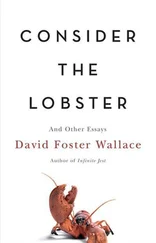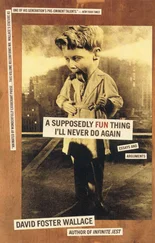(N.B. Purely as an autobiographical aside, I’ll insert that my use of my full middle name in published writing has its origins in this early confusion and trauma, i.e., trauma at being threatened at first with blame for the whole snafu, which, though egregious bullshit, was still understandably traumatic for a twenty-year-old green recruit with a fear of bureaucracies and one so-called ‘honor code’ violation, however specious and hypocritical, in his background already. For years afterward, I had morbid anxieties about there being God only knew how many other David Wallaces running around out there, doing God knows what; and I never again wanted to be professionally mistaken for or conflated with some other David Wallace. And then once you’ve fixed on a certain nom de plume, you’re more or less stuck with it, no matter how alien or pretentious it sounds to you in your everyday life.)
49 The subterranean level, which had been excavated and added (at staggering expense) to the main building in 1974–75, was designated Level 1, and the ground floor was therefore technically Level 2, which was additionally confusing because not all of the REC’s older, pre-excavation-and-addition signs had been changed out, and these signs and directories still identified the main, ground level as 1, the level above that 2, and so on, so that one could get any orientational help from these older directories and ‘You Are Here’ maps only if one knew in advance to recalibrate every level number upward by one, which was another piece of easily correctable institutional idiocy that Mr. Stecyk was grateful to have brought to his attention but embarrassed that he hadn’t seen and fixed before, and in essence took full responsibility for, even though technically it was the responsibility of Mr. Lynn Hornbaker and the Physical Plant office to have seen and amended the signs many years before, which is one reason why the process of getting the new design and makeup of the signs contracted and requisitioned then turned out to be so fraught and pointlessly complex — by making the sign thing as difficult and complex as possible, Hornbaker’s staff helped allay and diffuse responsibility for the signs’ not having been caught and amended years before, such that by the time the REC Director’s office heard about the issue, it was through a cloud of internal memos and cc’s so involved and opaque that no one not directly involved would have paid anything more than vague attention to the very general details of the snafu.
50 These double doors were gray steel, and this was the overall color scheme of Level 1—searing white and matte gray.
51 (the Midwest of which RSCs was in that era located in East St. Louis, two hours southwest)
52 (FYI, late spring was always an exceptionally bad time, skin-wise, during this era; and the harsh fluorescents of Level 1 threw every blister, scab, and lesion into merciless relief.)
53 The logistical information, too, is postdated, strictly speaking. On the day itself, I couldn’t have told you where in the building we even were by this time; no one could have.
54 = Deputy Director of Personnel, which was Mr. Stecyk’s official job title. My IRS contract, by the way, was signed not by Mr. Stecyk or by DP Richard Tate, but by Mr. DeWitt Glendenning Jr., whose bivalent titles were DREC (Director — Regional Examinations Center) and ARCE (Asst. Regional Commissioner for Examinations), but who was referred to by almost everyone as ‘Dwitt.’
55 (This turned out to be Mrs. Marge van Hool, Mr. Stecyk’s adjutant and right arm, who had the lashless, protuberant, unblinking eyes of a reptile or squid, something that could kill and eat you without its bulging alien stare ever changing, although Mrs. van Hool turned out to be the veritable salt of the earth, a classic instance of the truth that what most people look like has very little to do with their intrinsic human qualities… a truth I held quite dear at this time of my life.)
56 (during which interval, through momentary sight lines, I witnessed the Iranian Crisis first reading a paperback book and then at a later point attending to one sleeve of her gas-blue jacket with some kind of small portable sewing implement — she was clearly someone well-suited by temperament and/or experience to standing in long lines)
57 (i.e., nauseously warmed by the heat of some stranger’s back and bottom)
58 I would learn only much later that Mrs. Sloper’s son had been badly burned in some kind of vehicle accident while in the service, and that the state of my skin hit her harder than the average mom. At the time, all I knew was that we despised each other on sight, as of course can happen with some people.
59 In the usual way of twenty-year-olds, when home in Philo, I made a point of arguing with members of my family about their political attitudes, and yet then outside the home I often found myself reflexively holding, or at least sympathizing with, those same parental attitudes. I suppose all this meant was that I hadn’t yet formed a stable identity of my own.
60 (whose personal strengths did not include perceptiveness — and I am far from the only member of the family to observe this; trust me)
61 There was, though, an oral exchange that I overheard involving two or possibly three unseen voices in the narrow hallway my chair was near the ingress of, from two REC personnel presumably standing waiting in some sort of line in that hallway, which I remember (the exchange) in detail because the waiting area’s fluorescent lighting was gray-white and blinding and shadowless, the kind of light that makes people want to kill themselves, and I couldn’t imagine spending nine hours a day in light like this, and so I was emotionally primed to pick this exchange out of the overall ambient noise of the room’s exchanges, even though I could see neither party who was speaking; and I actually transcribed parts of the conversation in real time in a kind of personal shorthand on the inside of the pop psychology book’s front cover, in order to transfer it later to the notebook (which is why I am able now to recount it in such potentially suspicious-looking detail); to wit:
‘That’s the short version?’
‘Well, the point is just that Systems is not uncreative. You can’t paint them all with the same brush.’
‘Not uncreative? What kind of word is that?’
‘The up-front cost-savings of fluorescent lights were obvious. All you had to do was compare power bills. Fluorescent lighting in Exam Centers was doctrine. But Lehrl found, at least in La Junta, that replacing the inset fluorescents with banked incandescents and desk lamps increased efficiency.’
‘No, all the Systems boys found is that throughput of returns increased after fluorescents were changed out for lamps.’
‘Again, no. What Lehrl’s team found was that the net audit receipts of the Western REC’s monthly throughput increased, for each of the three quarters following the installation of incandescents, by an amount next to which the combined installation cost and increased monthly power cost of incandescents was almost negligible, assuming you amortized the one-time expense of taking out all the fluorescents and fixing the ceiling.’
‘But they never did prove that the incandescents had a direct causal link to the increased audit receipts.’
‘But how do you prove that? A Region’s balance sheet is thousands of separate pages. The increased receipts flowed from district offices spread all over the West. There’s too many variables to account for — a single connection is unprovable. That’s why it requires creativity. Lehrl’s boys knew there was a correlation. They could just never get anyone at Triple-Six to accept it.’
‘That’s your interpretation.’
‘They want everything quantified. But how do you quantify morale?’
Читать дальше












